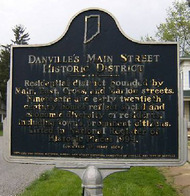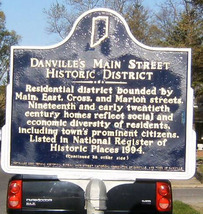Get Involved: Marker Hunt 2012
Do you love historical markers? If you do, and you like to travel, join in IHB's annual Marker Hunt! The Marker Hunt serves many purposes. It is IHB's inventory mechanism, allowing us to make sure all the markers we've placed are still standing. But, more importantly, it helps us identify persistent vandalism, deterioration, and safety issues so that we can prioritize repair needs, assist volunteers in identifying markers needing a fresh coat of paint, and answer questions from the public about the state of the marker program.
Putting our best foot forward for the bicentennial, IHB's goal is to have as many communities involved as possible, working toward having all 475+ Indiana State Historical Markers throughout the state rated in "Excellent" condition by 2016. The Marker Hunt is easy, fun, and appropriate for individuals and groups of all ages. All you need is a few minutes and a camera. Learn more here.
 IHB is now on Flickr! Check out the progress that's already been made on this year's Marker Hunt and see recent repairs and restorations. |
 The [Mock] Campaign Trail
"What is Indiana's state animal?" This question ranks among IHB's top 20 research questions and internet queries! Indiana is one of only 3 states in the U.S. without a land, marine, or domestic mammal as a state emblem.
Last year, at the Indiana State Fair, we asked fairgoers to identify state emblems, from the state tree to the unofficial state beverage. This year, we're going to mix it up with a good old-fashioned mock election. If we had a state animal what should it be? We asked our colleagues at the Indiana Department of Natural Resources and Indiana State Museum to nominate native creatures past and present to compete in our first Unofficial Indiana State Animal Mock Election. We'll be hosting meet-the-candidates sessions and primaries for the Prehistoric, Pioneer, and Modern parties on our Facebook page between May 15 and August 3. The Bean Count will occur during the fair, with voters casting their beans at our booth on Hoosier Heritage Day on August 9. There will also be opportunities to vote early at the DNR Fish & Wildlife Building.
Are you "registered" to vote? It's easy. Just "Like" us on Facebook to learn about the candidates and vote in the "primaries" this summer.
|
Spotlight on John McClain
Marker Repair Volunteer
“I love the smell of Rust-o-leum in the morning," John McClain says jokingly, when asked why he participates in the Marker Repair and Maintenance program with IHB. John has just completed restoration of the Danville's Main Street and Historic District marker (Hendricks Co.). He elaborates on his motivation: "I am of the opinion that it is an opportunity to honor two sets of Hoosiers: the first, of course, are those who felt an event was noteworthy enough to commemorate it with a placard and their effort to arrange for its creation. The second is the people and place being honored. As citizens – of a local community, a state, a nation – we have an obligation to respect and recall for future generations the progress made on our behalf by others who have come before us. I will likely never do anything famous or remarkable, so this allows me to ‘leave my mark’ on history by, in a small way, preserving it.”
 |
|
Left: Danville's Main Street and Historic District before. |
Right: Danville's Main Street and Historic District after. |
|
 |
|